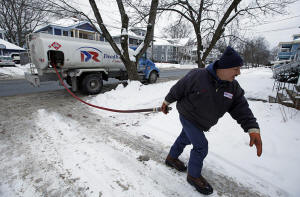Trump administration fires staff of program that helps low-income
households pay for heat
[April 04, 2025]
By SUSAN HAIGH
The Trump administration has laid off the entire staff of a $4.1 billion
program that helps millions of low-income households pay for heat during
the winter, unnerving state officials who are now wondering whether they
will still receive millions of dollars in expected federal payments.
The roughly two dozen workers who ran the Low Income Home Energy
Assistance Program were among 10,000 people fired as part of a dramatic
restructuring of the Department of Health and Human Services, according
to Mark Wolfe, executive director of the National Energy Assistance
Directors Association.
He said several senior employees who oversee the program, which serves
about 6.2 million households annually, told him they were locked out of
their building after arriving to work Monday.
“The way they did it, there was no like warning,” he said.
On Thursday, 13 U.S. senators, including two Republicans, sent a letter
to Health Secretary Robert F. Kennedy Jr. urging the administration to
reverse its decision to cut the LIHEAP staff. They warned the
terminations will undermine the agency's ability to provide a “crucial
lifeline” for low-income seniors and families.
The program had already delivered the bulk of its aid to the states for
this fiscal year but had yet to distribute $378 million.
It also helps households pay for the cost of air conditioning during
sweltering summer months.

When asked about the fate of LIHEAP and the outstanding payments, Emily
Hilliard, deputy press secretary for HHS, said in a statement: “HHS will
continue to comply with statutory requirements, and as a result of the
reorganization, will be better positioned to execute on Congress’s
statutory intent.”
Speaking about the broader overhaul of his agency, Kennedy has said it
needs to be “recalibrated."
Without any staff in place, states are questioning how and if they will
get the rest of their money, especially for upcoming summer cooling
programs.
[to top of second column]
|

Paul Dorion, a driver for the Downeast Energy, delivers heating oil
to a home in Portland, Maine, Jan. 14, 2015. (AP Photo/Robert F.
Bukaty, File)

“Will we receive our remaining funds? If we don’t, some states will
not run their cooling programs this summer. They’ll scale them
back,” Wolfe said.
State officials involved in distributing aid said they are concerned
LIHEAP will collapse without federal support.
“Emails bounce back from people that we have worked with for many
years, who are deeply knowledgeable of the program,” said Peter
Hadler, deputy director of the Connecticut Department of Social
Services, noting his state is still owed $8 million.
In Minnesota, where the northern part of the state received a foot
of snow Wednesday, the state's Department of Commerce predicted that
by mid-April it will run out of money to help new applicants seeking
help with heating and electric bills.
The state had been expecting an additional $12 million to $13
million in federal funding, already approved by Congress. Those
funds would help more than 10,000 households pay their utility bills
and prevent power shutoffs. About 130,000 Minnesota households
receive assistance each year through LIHEAP.
“Winter is still happening in Minnesota. It snowed yesterday,” said
Pete Wyckoff, deputy commissioner of energy resources at the
department. “We do need that extra money to come through to get us
through the rest of the winter season.”
Eligibility can differ by state, as well as the specific services
provided. In general, the program assists families in covering
utility bills or the cost of paying for home heating oil. It has
received bipartisan congressional support for decades.
Sens. Susan Collins of Maine and Lisa Murkowski of Alaska were the
two Republicans who signed on to the letter imploring Kennedy to
reverse any staffing or funding cuts that would jeopardize the
program.
All contents © copyright 2025 Associated Press. All rights reserved |